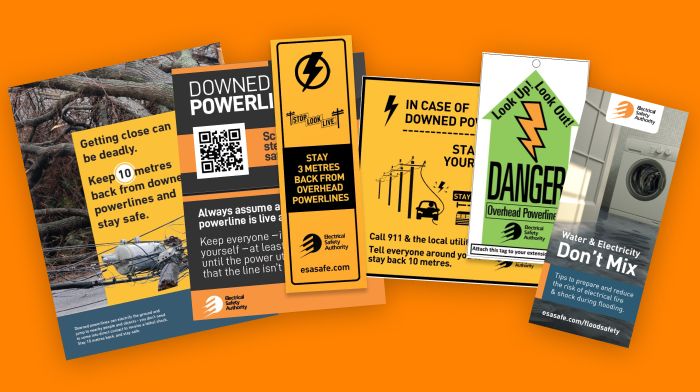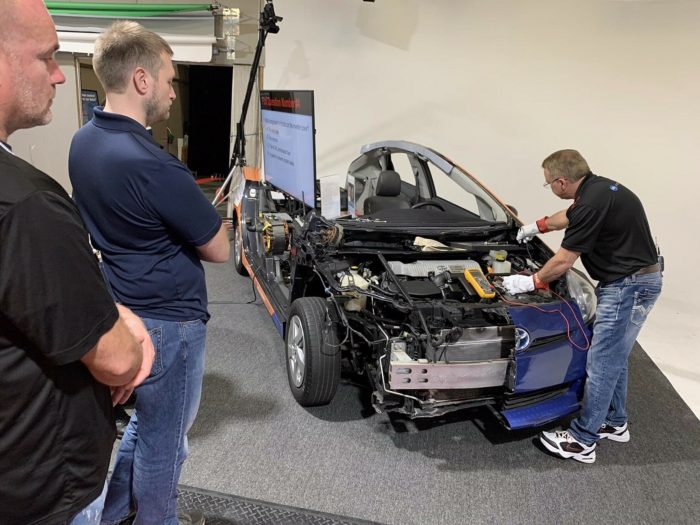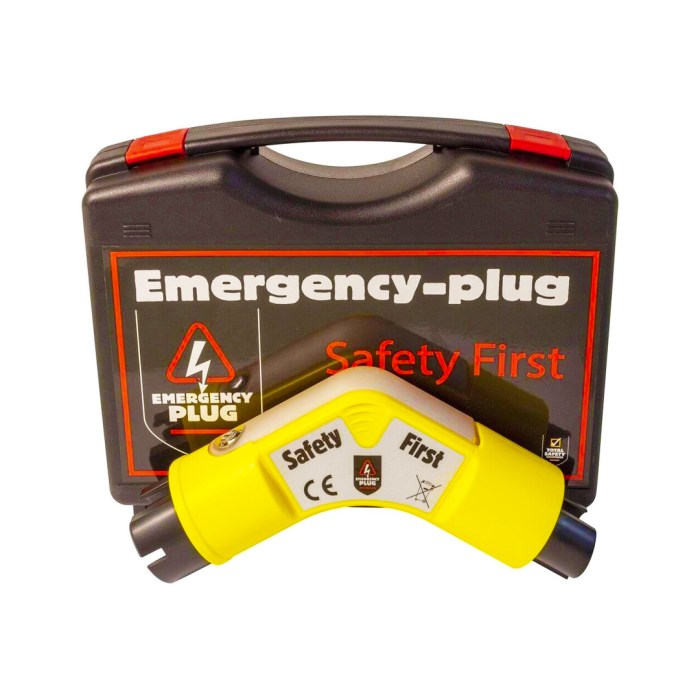EV Emergency Response Guides for First Responders: Dude, electric vehicles are awesome, but when things go south—like a battery fire or a high-voltage mishap—it’s a whole different ball game. This guide is your cheat sheet for handling EV emergencies, covering everything from understanding those crazy battery fires to safely extracting folks from wrecked EVs. We’re talking real-world scenarios and practical advice, so buckle up!
This guide breaks down the unique challenges EVs present to first responders. We’ll explore the specific fire hazards of EV batteries, contrasting them with gasoline-powered vehicles. You’ll learn about high-voltage system safety, mastering de-energization techniques and essential PPE. We’ll also cover extrication strategies tailored for EVs, highlighting specialized tools and procedures. Finally, we’ll delve into post-incident procedures, including scene security, reporting, and evidence collection.
It’s all about being prepared for anything.
EV Battery Fire Characteristics
Electric vehicle (EV) battery fires present unique challenges to first responders compared to gasoline-fueled vehicle fires. The intensity, duration, and difficulty in extinguishing these fires require specialized knowledge and techniques. Understanding the specific hazards associated with EV batteries is crucial for ensuring responder safety and effectively mitigating the incident.
EV Battery Fire Hazards
EV battery fires differ significantly from gasoline fires in several key aspects. Gasoline fires are typically fast-burning and relatively easy to extinguish with water or foam. In contrast, EV battery fires can burn intensely for extended periods, reignite after apparent extinguishment (a phenomenon called “rekindling”), and produce toxic fumes. The high energy density of EV batteries means a larger amount of thermal energy is released during a fire, leading to more intense heat and longer burn times.
The complex chemical reactions within the battery during a fire can also generate hazardous gases, including hydrogen cyanide and carbon monoxide.
EV Battery Chemistries and Fire Behavior
The most common EV battery chemistries are lithium-ion (Li-ion), specifically lithium iron phosphate (LFP) and nickel manganese cobalt (NMC). These chemistries influence fire behavior. LFP batteries, while still capable of thermal runaway, generally exhibit less intense fires and are less prone to reignition compared to NMC batteries. NMC batteries, while offering higher energy density, tend to be more susceptible to thermal runaway and more violent fires.
Understanding the specific battery chemistry involved in an incident is helpful in predicting fire behavior and selecting appropriate extinguishing agents.
Thermal Runaway in EV Batteries
Thermal runaway is a cascading process of exothermic reactions within a battery cell that leads to a self-sustaining fire. It begins with an initial event, such as an impact, overcharging, or internal short circuit, which generates heat. This heat triggers further chemical reactions, releasing more heat, and escalating the process. The heat buildup can cause cell rupture, venting of flammable gases, and ultimately, a fire.
The thermal runaway process is difficult to stop once initiated, requiring significant intervention to control the fire.
Assessing the Risk of Thermal Runaway
Assessing the risk of thermal runaway during an EV incident involves a systematic approach.
- Visual Inspection: Observe the vehicle for signs of damage, smoke, or flames. Look for any visible signs of battery damage, such as bulging or venting cells.
- Vehicle History: If possible, obtain information about the vehicle’s history, including any previous incidents or maintenance records. This can provide clues about the potential for battery issues.
- Incident Circumstances: Consider the circumstances surrounding the incident, such as the nature of the impact or the presence of any electrical hazards. This can help determine the potential cause of the battery fire.
- Temperature Monitoring: If available, use thermal imaging cameras to assess the temperature of the battery pack. Elevated temperatures can indicate the potential for thermal runaway.
- Battery Location: Identify the location of the battery pack within the vehicle. This information is crucial for strategic deployment of extinguishing agents and cooling techniques.
Extinguishing Agents for EV Battery Fires
The effectiveness of different extinguishing agents varies depending on the stage of the fire and the type of battery. Water, while effective for cooling, can cause thermal shock and potentially accelerate the reaction in some cases.
| Agent Type | Effectiveness | Limitations | Safety Precautions |
|---|---|---|---|
| Water | Effective for cooling, may not extinguish the fire completely | Can cause thermal shock, potentially worsening the situation; may lead to steam explosion if applied to hot batteries. | Use large quantities, maintain a safe distance, wear appropriate PPE. |
| Class A Foam | Moderately effective for cooling and suppressing flames | May not penetrate the battery pack effectively | Ensure adequate coverage and continued application. |
| Dry Chemical (e.g., Potassium Bicarbonate) | Can suppress flames, but may not cool the battery effectively | Limited effectiveness in preventing reignition | Avoid inhalation, wear appropriate respiratory protection. |
| High-Expansion Foam | Effective for cooling and suppressing flames, creating a blanket to isolate the battery | Requires specialized equipment and training | Ensure proper application techniques. |
High-Voltage System Hazards

Electric vehicles (EVs) present unique challenges for first responders due to their high-voltage electrical systems. Unlike traditional internal combustion engine vehicles, EVs operate on high-voltage batteries and associated components that pose significant risks of serious injury or death if mishandled. Understanding these hazards and implementing appropriate safety procedures is crucial for the protection of both first responders and the public.
High-Voltage System Hazards Identification
EV high-voltage systems typically operate at voltages ranging from 200 to 800 volts DC, far exceeding the typical household voltage of 120 volts AC. Contact with these high-voltage components can result in severe electrical shock, burns, and even cardiac arrest. Additionally, the high energy stored in the battery pack can lead to thermal runaway, resulting in intense fires that are difficult to extinguish and release toxic fumes.
Other hazards include arc flash, which can cause severe burns to exposed skin and eyes, and the potential for explosions due to the release of flammable gases during a battery fire.
High-Voltage System De-energization Procedures
Safely de-energizing an EV’s high-voltage system is paramount before any intervention. This process typically involves several steps and should be strictly followed according to the manufacturer’s guidelines, which are often found in the vehicle’s service manual or online. Generally, this involves isolating the battery pack from the rest of the vehicle’s electrical system, often through the use of a main high-voltage disconnect switch.
After disconnecting, the system should be verified as de-energized using a non-contact voltage detector before any further work is attempted. Remember that residual voltage may remain in the system even after disconnection, necessitating careful and cautious handling.
Personal Protective Equipment (PPE) Requirements
Working near high-voltage components demands the use of appropriate personal protective equipment (PPE). This includes insulated gloves rated for the voltage levels present in the EV, insulated footwear, eye protection, and flame-resistant clothing. The specific PPE requirements will vary depending on the task and the voltage level, but a minimum level of protection is crucial to minimize risk.
Additionally, responders should be aware of the limitations of their PPE and should not rely solely on it for protection.
Best Practices for Preventing Electrical Shock
Preventing electrical shock during EV emergency response requires a combination of knowledge, training, and adherence to established safety procedures. Before approaching an EV, responders should visually inspect the vehicle for any signs of damage to the high-voltage system. Maintaining a safe distance from exposed high-voltage components is crucial, and any work near these components should be performed only after the system has been de-energized and verified as safe.
Regular training and refresher courses on EV safety are essential for first responders to stay updated on best practices and evolving technologies.
Safe Approach and Securing an EV: A Flowchart
The following flowchart illustrates the steps involved in safely approaching and securing an EV at an incident. This is a simplified representation and should be adapted to the specific situation and the manufacturer’s guidelines.[The flowchart would be depicted here visually, but as per the instructions I cannot create a visual. A textual description follows.] Flowchart:
1. Scene Assessment
Evaluate the situation for hazards (fire, downed power lines, etc.). Ensure scene safety before approaching.
2. Initial Vehicle Assessment
Observe the vehicle for any obvious damage to the high-voltage system.
3. Emergency Vehicle Placement
Park emergency vehicles at a safe distance to avoid contact with the EV.
4. Consult Manufacturer’s Information
Locate the high-voltage disconnect switch location and de-energization procedure.
5. High-Voltage System De-energization
Follow the manufacturer’s instructions to safely disconnect the high-voltage system.
6. Voltage Verification
Use a non-contact voltage detector to verify the system is de-energized.
7. PPE Donning
Put on appropriate PPE (insulated gloves, eye protection, etc.).
8. Safe Intervention
Proceed with the necessary emergency response actions (extrication, etc.).
9. Post-Intervention
Remove PPE, secure the scene, and follow post-incident procedures.
Emergency Vehicle Extrication Techniques: EV Emergency Response Guides For First Responders

Extricating occupants from electric vehicles (EVs) presents unique challenges compared to gasoline-powered vehicles due to the presence of high-voltage batteries and the potential for thermal runaway. Understanding these differences is crucial for first responders to ensure both victim safety and their own. This section details the necessary techniques, tools, and safety precautions.
Extrication Technique Comparisons: EVs vs. Gasoline Vehicles
While the fundamental principles of vehicle extrication remain the same—stabilizing the vehicle, accessing the victim, and removing them safely—EVs introduce significant complexities. Traditional extrication methods might inadvertently damage the high-voltage battery system, leading to electrocution or thermal runaway (a self-sustaining fire). Therefore, strategic planning and specialized tools are essential to minimize risks. For instance, cutting through a gasoline-powered vehicle’s frame is relatively straightforward, whereas cutting near an EV’s battery pack requires careful consideration of potential energy hazards.
Okay, so we’re talking EV emergency response guides for first responders, right? A big part of that is understanding the different types of EVs and their potential hazards. But also, think about the future – more people will be charging their EVs at home, potentially with solar power, like what’s discussed in this article on Solar-powered EV charging at home 2025.
This means first responders might need updated training to handle incidents involving home charging setups. Getting those guides up-to-date is crucial for responder safety.
Challenges Posed by EV Battery Packs During Extrication
EV battery packs are large, heavy, and contain a significant amount of stored energy. Damage to these packs can lead to thermal runaway, resulting in intense fires that are difficult to extinguish. The risk of electrical shock from high-voltage components remains even after the vehicle’s power has been apparently shut down. Furthermore, the location and design of the battery pack within the vehicle’s structure can complicate access to trapped occupants.
For example, a battery pack might be positioned under the passenger compartment, requiring specialized lifting and removal techniques.
Specialized Tools and Equipment for EV Extrication, EV emergency response guides for first responders
Effective EV extrication requires specialized tools and equipment designed to mitigate the risks associated with high-voltage systems and thermal runaway. These include:
- High-voltage detectors and insulated tools: To confirm power is off and to safely work around the high-voltage system.
- Thermal imaging cameras: To detect potential hotspots and prevent thermal runaway.
- Battery pack shutoff tools: To safely disconnect the battery pack from the vehicle’s electrical system.
- Specialized cutting tools: To minimize damage to the battery pack during extrication.
- Lifting and moving equipment: To safely remove the battery pack or portions of the vehicle if necessary.
- Fire suppression systems specifically designed for EV battery fires: These often involve specialized foams or agents that can cool and suppress the fire effectively.
Step-by-Step Procedure for Safe EV Occupant Removal
A systematic approach is crucial for safe EV extrication. The steps generally involve:
- Scene Assessment and Hazard Identification: Assess the scene for immediate dangers, including downed power lines, leaking fluids, and fire hazards. Identify the location of the high-voltage battery pack.
- Vehicle Stabilization and Power Isolation: Secure the vehicle to prevent further movement. Use high-voltage detectors to confirm the vehicle’s electrical system is de-energized. If possible, utilize the vehicle’s battery shutoff system.
- Access Point Creation: Strategically plan the access point, avoiding damage to the battery pack as much as possible. Use specialized cutting tools to create access to the trapped occupant.
- Victim Removal: Carefully remove the victim, minimizing any further risk of injury. Use appropriate lifting and moving techniques.
- Post-Extrication Procedures: Ensure the scene is safe before leaving. Properly secure the vehicle and the battery pack, and report any necessary information to the appropriate authorities.
Safety Precautions During EV Extrication
Prioritizing safety is paramount during EV extrication. Failure to follow these precautions can lead to serious injury or death:
- Always assume the high-voltage system is energized until proven otherwise.
- Use only insulated tools and equipment when working near high-voltage components.
- Maintain a safe distance from the battery pack, especially if there are signs of thermal runaway.
- Wear appropriate personal protective equipment (PPE), including protective clothing, gloves, and eye protection.
- Follow established safety protocols and procedures.
- Have a clear communication plan with your team members.
- Be aware of the potential for secondary hazards such as fire and toxic fumes.
Post-Incident Procedures
Okay, so the fire’s out, the scene is (hopefully) safe, and everyone’s accounted for. Now what? Post-incident procedures for EV fires are crucial not just for safety, but also for investigation and preventing future incidents. Proper handling ensures the well-being of first responders, protects the environment, and helps determine the cause of the fire.
Damaged EV Battery Handling
After an EV fire, the battery pack is often severely damaged and presents ongoing hazards. Never assume the battery is completely inert, even after the visible flames are extinguished. Thermal runaway can occur hours later. The battery pack should be treated as a hazardous materials spill, requiring specialized handling and disposal. First responders should establish a safety perimeter well beyond the immediate fire zone, and contact specialized EV recovery teams equipped to safely disconnect the high-voltage system and remove the battery pack.
These teams have the appropriate personal protective equipment (PPE) and tools to handle the damaged battery safely. Improper handling can lead to reignition, further damage, or injury.
Scene Security After an EV Fire
Securing the scene involves more than just putting out the flames. It requires establishing a wide perimeter to prevent unauthorized access and further potential hazards. This includes controlling traffic, keeping bystanders at a safe distance, and preventing anyone from approaching the vehicle until the high-voltage system is deemed safe. The scene should be monitored for potential reignition or further hazards, such as leaking fluids or structural instability of the vehicle.
Okay, so EV emergency response guides for first responders are super important, right? I mean, dealing with high-voltage batteries and all that is no joke. But what about the added layer of complexity from autonomous features? Check out this article on Autonomous driving features in 2025 EVs to see what first responders might be facing. Understanding these systems is key to creating effective and safe EV emergency response guides for the future.
Specialized equipment, such as thermal imaging cameras, may be used to identify hot spots that might indicate a risk of reignition. Proper scene security is vital for the safety of emergency personnel and the public.
Reporting EV Incidents
Reporting an EV incident involves notifying several authorities, depending on the severity and circumstances. This typically includes local fire departments, law enforcement, and potentially the vehicle manufacturer. Accurate and detailed reporting is critical for investigation and improving safety protocols. The report should include the location, time, type of vehicle, any injuries sustained, and a description of the incident, including any unusual circumstances or observations.
This information helps establish a timeline and aids in identifying potential causes. Contacting the vehicle manufacturer is important as they can provide specific information about the battery system and any potential contributing factors.
Documenting EV Incidents and Evidence Collection
Thorough documentation is essential for any investigation into an EV fire. This involves taking detailed notes, photos, and videos of the scene, the vehicle, and any damage. Photographs should be taken from multiple angles and include close-ups of any damage to the battery pack, charging equipment, or other components. Videos can provide a more comprehensive record of the incident, capturing the sequence of events and the overall scene.
Evidence collection should follow established protocols, ensuring chain of custody is maintained to preserve the integrity of any evidence collected. This evidence will be crucial for determining the cause of the fire and preventing similar incidents in the future.
Creating a Detailed Incident Report
A detailed incident report should follow a structured format to ensure all relevant information is included. A suggested format includes sections for: Incident Details (date, time, location, vehicle information); Responding Agencies (list of agencies involved); Witness Statements (summary of witness accounts); Damage Assessment (description of damage to vehicle and surrounding area); Photographs (with detailed descriptions of each photo, such as “Photo 1: Overall view of the vehicle showing extensive fire damage to the rear,” “Photo 2: Close-up of the damaged battery pack showing melted casing and exposed cells”); and Recommendations (suggestions for preventing future similar incidents).
This detailed record helps investigators understand the incident, and contributes to improving EV safety.
Training and Education for First Responders

Effective training is paramount for first responders dealing with electric vehicle (EV) emergencies. The unique hazards presented by high-voltage systems and the potential for thermal runaway in EV batteries necessitate specialized knowledge and skills beyond traditional emergency response training. Failure to adequately prepare first responders puts both them and the public at significant risk.Proper training equips first responders with the knowledge and skills to safely and effectively manage EV-related incidents, minimizing risks to themselves and the public.
This includes understanding the specific hazards of EVs, employing appropriate safety procedures, and utilizing specialized equipment. Hands-on experience is crucial for developing the necessary proficiency and confidence in handling these complex situations.
Key Elements of Effective EV Emergency Response Training Programs
Effective EV emergency response training programs should incorporate a multi-faceted approach, combining classroom instruction, simulations, and extensive hands-on training. These programs need to go beyond theoretical knowledge and equip responders with the practical skills to handle real-world scenarios. This includes familiarity with EV architecture, battery systems, and the specialized tools and techniques required for safe intervention.
Importance of Hands-on Training with EVs and Specialized Equipment
Hands-on training is not merely supplementary; it’s absolutely critical. Classroom instruction provides the theoretical foundation, but practical experience allows responders to develop muscle memory and build confidence in handling potentially dangerous situations. Working with actual EVs and specialized equipment, such as high-voltage detectors and insulated tools, allows trainees to become comfortable with the procedures and equipment before facing a real emergency.
Simulated scenarios replicate the stress and urgency of real incidents, enhancing the training’s effectiveness.
Best Practices in EV Emergency Response Training Programs
Several best practices have emerged in the field of EV emergency response training. Many successful programs incorporate scenario-based training, using realistic simulations to challenge responders and reinforce learned skills. Regular refresher courses are essential to keep responders up-to-date with evolving technologies and best practices. Collaboration between manufacturers, training organizations, and emergency services agencies is also crucial for developing standardized training materials and ensuring consistency across jurisdictions.
For example, some fire departments partner with local EV dealerships to access vehicles for training exercises, ensuring realism and familiarity with different EV models.
A Training Curriculum for First Responders Focused on EV Emergency Response
A comprehensive training curriculum should include the following key topics:
- Introduction to Electric Vehicles: Basic EV architecture, battery types (e.g., lithium-ion), charging systems, and common EV models.
- High-Voltage System Hazards: Identifying high-voltage components, understanding the risks of electrical shock and arc flash, and implementing safety protocols.
- EV Battery Fire Characteristics: Understanding the unique characteristics of EV battery fires, including thermal runaway, the challenges of extinguishment, and the potential for reignition.
- Emergency Vehicle Extrication Techniques: Safe procedures for extricating occupants from EVs, considering the presence of high-voltage systems and potential battery hazards.
- Specialized Equipment and Tools: Proper use and maintenance of high-voltage detectors, insulated tools, and specialized firefighting equipment for EV incidents.
- Incident Scene Management: Establishing a safe perimeter, coordinating with other emergency responders, and managing the scene effectively to mitigate risks.
- Post-Incident Procedures: Safe shutdown procedures, decontamination, and reporting protocols following an EV emergency.
- Hands-on Training and Simulations: Practical exercises using actual EVs and specialized equipment, including simulated rescue scenarios and fire suppression drills.
Last Word
So, yeah, responding to EV emergencies is different, but with the right knowledge and training, you’re totally equipped to handle it. This guide provides the foundational information you need to stay safe and effectively manage EV incidents. Remember, preparedness is key – stay updated on the latest techniques and technologies, and always prioritize safety for yourself and those you’re helping.
Let’s keep our communities safe, one EV emergency at a time!









